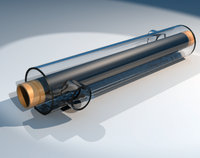
Photo from wikipedia
Abstract An experimental study for air-side thermal-hydraulic performance of louvered fin-and-flat-tube heat exchanger under dehumidifying conditions has been performed. The louvered fin studied, used for an automotive evaporator, is geometrically… Click to show full abstract
Abstract An experimental study for air-side thermal-hydraulic performance of louvered fin-and-flat-tube heat exchanger under dehumidifying conditions has been performed. The louvered fin studied, used for an automotive evaporator, is geometrically defined by a flow depth of 47 mm, a high louver angle of 50° and a louver pitch of 1.1mm. The test was conducted for frontal air velocity ranging from 1.1 to 4.5 m/s. The heat exchanger was tested first in dry condition, working as a heater. In wet conditions, the cooling coil was tested for three air inlet temperatures, Ta, and for various inlet relative humidity, RH, organized as follows: Ta = 30 °C (RH = 40 to 70%), Ta = 35 °C (RH = 30 to 60%), and Ta = 40 °C (RH = 20 to 60%); which correspond to a variation of the inlet humidity ratio from 9.2 to 27.7 gwater/kgdry-air. It was found that, for all inlet conditions, the wet friction factor is higher than that for dry surface (up to 43%). Concerning the heat transfer performance, at low Reynolds number, the sensible Colburn ‘j’ factor is insensitive to the surface conditions. However, as Re number increases, the sensible wet j factor decreases (up to 23%) compared to the dry one. This degradation is more and more pronounced as the inlet humidity ratio increases.
Journal Title: Applied Thermal Engineering
Year Published: 2021
Link to full text (if available)
Share on Social Media: Sign Up to like & get
recommendations!